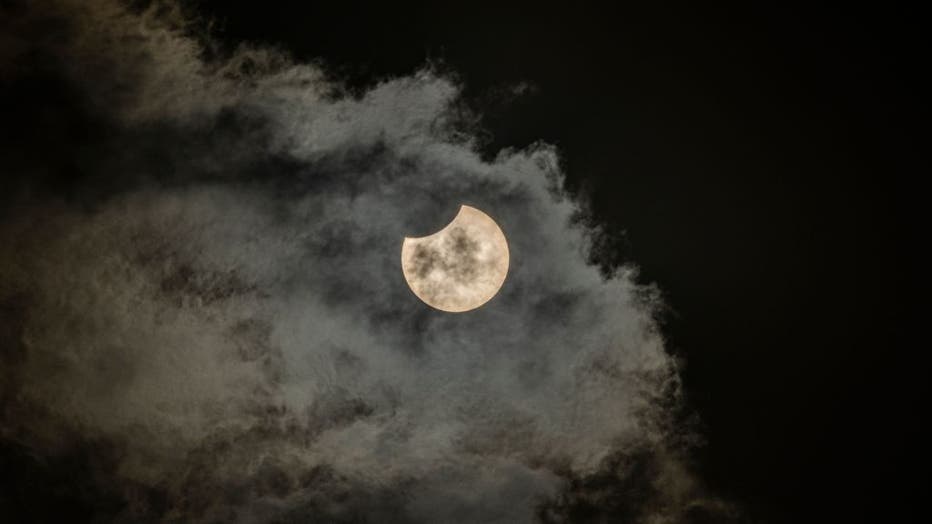What happens if it's cloudy during the eclipse? The answer depends, researchers say

Anatomy of a solar eclipse
FOX 4's Dan Henry breaks down what exactly will happen during the total solar eclipse on April 8. (Video courtesy of FOX 4 Dallas)
A clear sky is optimal for viewing the upcoming total solar eclipse, but having clouds in the forecast won't necessarily ruin the moment.
According to FOX Weather, research shows that cumulus clouds can dissipate during even partial solar eclipses.
Research published in the journal Nature showed that the low, fluffy white clouds started to disappear when only 15% of the sun was shaded by the moon.
But it also depends on what type of clouds there are. Weather experts say viewers should hope for high clouds.
"If we want to see it, we’ll want the higher-level clouds," Tim Daldrup told Oregon Public Radio. "Those tend to be the more feathery cirrus clouds that can still be seen through. They might obstruct the eclipse but you can still see it."
RELATED: 16 of the coolest places to watch the solar eclipse

What is a solar eclipse? NASA expert explains
We speak with NASA senior research scientist Dr. Eric Christian ahead of the total solar eclipse. LiveNOW from FOX | Raw & unfiltered news
Will it still get dark if it's cloudy?
Darker and lower-level clouds could block out the eclipse completely. In that case, you'll miss seeing the dramatic change from day to night, but you'll still know there is an eclipse.
If you're in the area of totality – where the moon completely blocks the sun – it will still get dark for a few minutes. If it's cloudy, it could get quite dark.
"The eerie daytime darkness associated with eclipses is still noticeable with cloud cover," NASA noted.
Solar eclipses happen about twice a year, but finding yourself under a total of one is rare. According to the American Astronomical Society, any given spot on the planet only sees temporary darkness from the Moon’s shadow once every 400 years.

This picture taken on October 25, 2022 shows a view of a partial solar eclipse visible behind clouds in an overcast sky in Egypt's capital Cairo. (Photo by KHALED DESOUKI/AFP via Getty Images)
What's the forecast for the eclipse?
With less than a week until April 8, the FOX Forecast Center says the trend for clearer skies is improving at the northeastern end of the path of totality but is getting worse for clouds at the southwestern end of the eclipse path.
RELATED: Solar eclipse 2024 food deals and freebies that can’t be overshadowed
Buffalo, New York, is currently forecast to have some clouds on the day of the event, but less cloud cover is expected to the north and east. The forecast is looking favorable for Caribou, Maine, one of the last places to see the eclipse in the U.S. before the path of totality heads into Atlantic Canada.
For the Midwest, cloud cover could be less around Paducah, Kentucky, and near St. Louis but will increase closer to the Great Lakes region, including Cleveland.
For now, clouds remain most probable around the Great Lakes and Gulf Coast, with greater confidence in less cloud cover around Florida and New England.
Many of the prime viewing spots of Texas through the mid-Mississippi and Ohio valleys are currently forecast to have overcast skies or many clouds. Popular viewing spots, including San Antonio, may have trouble from clouds on April 8.

Preparations underway in Dallas for solar eclipse
FOX 4 Dallas's Alex Boyer joins LiveNOW's Andy Mac to relay how officials are preparing for next week's solar eclipse.
Total solar eclipse path
The April 2024 solar eclipse will be visible, at least in part, to nearly everyone in the U.S. But the path of totality – where the moon will completely block the sun – is a 115-mile-wide region that stretches from southern Texas up through Ohio, then over to northern Maine.
RELATED: Here's what an eclipse looks like from space
Large cities in the path of totality include:
- Austin, Texas
- Dallas, Texas
- Little Rock, Arkansas
- Carbondale, Illinois
- Indianapolis, Indiana
- Cleveland, Ohio
- Buffalo, New York
- Plattsburgh, New York
- Presque Isle, Maine
The farther you are from that path, less and less of the sun will appear to be blocked.
What time is the solar eclipse?
Southern Texas will see the peak of totality first, around 1:30 p.m. Central Daylight Time. Then Dallas at 1:42 p.m., with the time getting later and later as the moon’s shadow moves north. Indianapolis will see the peak around 3:05 p.m. Eastern Daylight Time; Cleveland at 3:15 p.m., and northern Maine around 3:30 p.m.
FOX Weather contributed to this report. This story was reported from Los Angeles.

